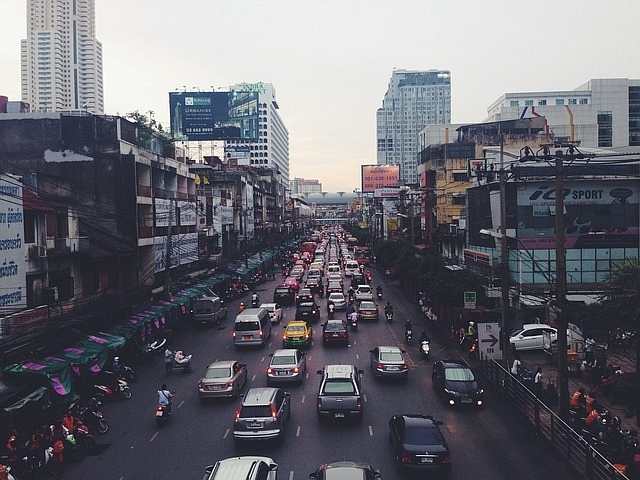Politics
Transport Sector: Five Mistakes That Governments Should Avoid In 2018
- The transport sector, despite being an area of focus and one with direct impact on people, often gets left out of debates on government dos and don’ts.
- We address that here. These are five mistakes that various government bodies should avoid in 2018.

Traffic jam in India
With the new year having rolled in, there has been plenty of talk on how the government should or should not take certain decisions. However, the transport sector is an important one that has been left out. The year 2017 and the preceding years taught us plenty of lessons in how not to manage the country’s already badly managed transit system.
Here are five mistakes that various government bodies should avoid this year:
1) Using antiquated laws to harass private players and commuters
Karnataka last year decided to use a now-30-year-old law to ban commercial carpooling services like Ola Share and uberPOOL in the state, particularly in the capital city of Bengaluru. While the ban did not take off, vehicles were seized by the traffic police, severely affecting the traffic as well as livelihoods of many people dependent on it.
Similarly, the transport department seized two-wheelers operating with the bike-sharing app, Rapido, saying they were unauthorised. While ride-sharing may not completely solve the traffic problems facing our urban centres, they act as short-to-medium-term solutions till major projects are completed. At the same time, states should be wary of invoking Section 99 of the Motor Vehicles Act (MV Act) to nationalise bus routes.
In September last year, the Madras High Court made it mandatory for drivers to carry their original driving licences, citing Section 130 of the MV Act. The act allows for those not in possession of their licence to send an attested copy to the authorities within 15 days. Most of the affected were truckers plying on interstate routes whose licences are often in the possession of their unions or companies.
2) Declaring everything that eats into the state’s revenue as illegal or imposing arbitrary bans
Several states, notably Karnataka (again), banned private buses by bus aggregators like Ola Shuttle and ZipGo from 2015 onwards. When the state could have set up a competent regulator to ensure proper bus services managed by both the public and private sectors, it decided not to and instead banned them. This arbitrary nature of imposing bans was extended to two-wheelers later by deciding to ban pillion riders on bikes with smaller engines.
3) Going over the top with newer modes of transport without a thorough evaluation
The centre (through the National Highways Authority of India) and Karnataka (once again) jumped the gun to go ahead with pod taxis as part of a large-scale personal rapid transit (PRT) system. While NHAI decided to slow down after the NITI Aayog red-flagged the proposal on concerns of safety and then decided to call for bids, the Bruhath Bengaluru Mahanagara Palike (BBMP) went ahead and invited tenders for construction. The Aayog recommended that interested parties build a 1km-long pilot project to evaluate the technology, which the NHAI decided to follow. While PRT systems will undoubtedly be good for commuters, it too, like any other project, needs to be planned better.
4) Scrapping services that would in turn cause congestion
In December 2016, the Bengaluru Metropolitan Transport Corporation (BMTC) decided to scrap nearly 6,000 routes daily (a month before asking ride-sharing firms to stop pooled rides). In April 2017, the Brihanmumbai Electricity Supply and Transport (BEST) Undertaking decided to curtail all its air-conditioned services, right at the time of peak summer in the city. BMTC scrapped its services due to a shortage of buses, while the story of BEST’s A/C buses is a well-known case study in corruption. All of this resulted in more vehicles on the roads, causing heavy congestion.
5) Forgetting the pedestrian
Most urban infrastructure projects in India look at roads from only the motorist’s point of view. Road development projects therefore often see a lack of pavements for pedestrians or grade-separated crossings like subways or foot-over bridges. While civic bodies in particular need to ensure that road development projects include footpaths, the traffic police is duty-bound to ensure that motorists stop at crossings or when the pedestrian signal is active. Violators need to be penalised in order to ensure that the pedestrian too is safe.
Also Read:
Support Swarajya's 50 Ground Reports Project & Sponsor A Story
Every general election Swarajya does a 50 ground reports project.
Aimed only at serious readers and those who appreciate the nuances of political undercurrents, the project provides a sense of India's electoral landscape. As you know, these reports are produced after considerable investment of travel, time and effort on the ground.
This time too we've kicked off the project in style and have covered over 30 constituencies already. If you're someone who appreciates such work and have enjoyed our coverage please consider sponsoring a ground report for just Rs 2999 to Rs 19,999 - it goes a long way in helping us produce more quality reportage.
You can also back this project by becoming a subscriber for as little as Rs 999 - so do click on this links and choose a plan that suits you and back us.
Click below to contribute.
Latest